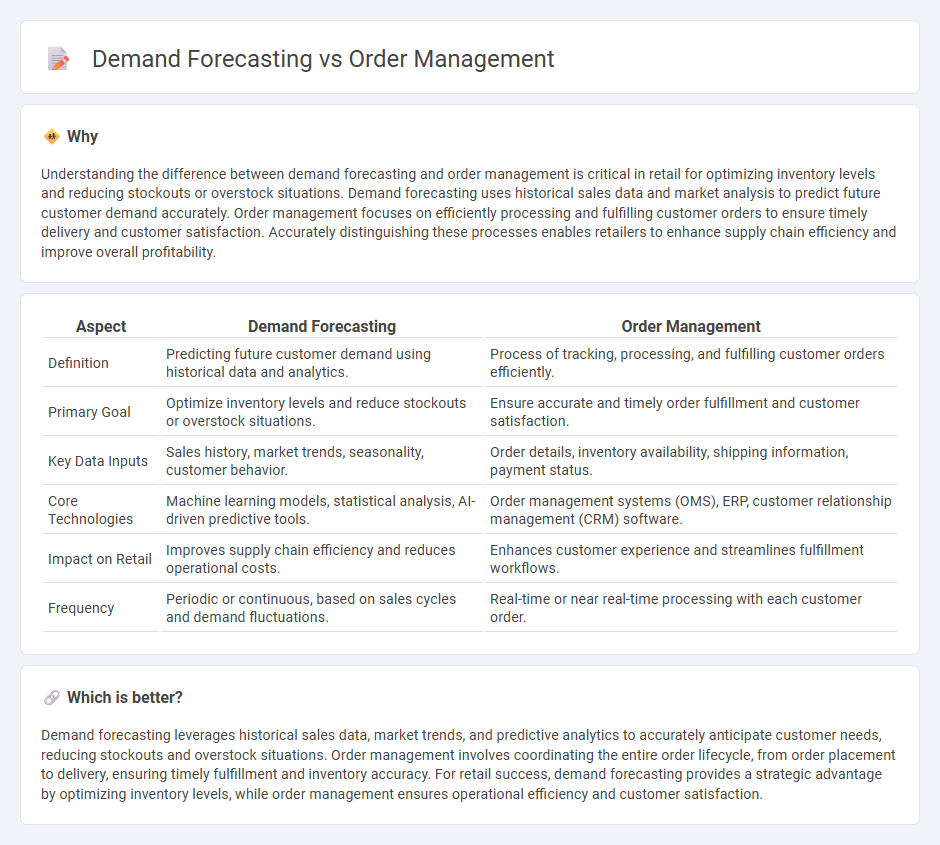
Demand forecasting leverages historical sales data, market trends, and consumer behavior analytics to predict future product demand, enabling retailers to optimize inventory levels. Order management focuses on streamlining the processing, tracking, and fulfillment of customer orders to enhance operational efficiency and customer satisfaction. Explore the critical differences and benefits of demand forecasting and order management in retail to boost your supply chain effectiveness.
Why it is important
Understanding the difference between demand forecasting and order management is critical in retail for optimizing inventory levels and reducing stockouts or overstock situations. Demand forecasting uses historical sales data and market analysis to predict future customer demand accurately. Order management focuses on efficiently processing and fulfilling customer orders to ensure timely delivery and customer satisfaction. Accurately distinguishing these processes enables retailers to enhance supply chain efficiency and improve overall profitability.
Comparison Table
| Aspect | Demand Forecasting | Order Management |
|---|---|---|
| Definition | Predicting future customer demand using historical data and analytics. | Process of tracking, processing, and fulfilling customer orders efficiently. |
| Primary Goal | Optimize inventory levels and reduce stockouts or overstock situations. | Ensure accurate and timely order fulfillment and customer satisfaction. |
| Key Data Inputs | Sales history, market trends, seasonality, customer behavior. | Order details, inventory availability, shipping information, payment status. |
| Core Technologies | Machine learning models, statistical analysis, AI-driven predictive tools. | Order management systems (OMS), ERP, customer relationship management (CRM) software. |
| Impact on Retail | Improves supply chain efficiency and reduces operational costs. | Enhances customer experience and streamlines fulfillment workflows. |
| Frequency | Periodic or continuous, based on sales cycles and demand fluctuations. | Real-time or near real-time processing with each customer order. |
Which is better?
Demand forecasting leverages historical sales data, market trends, and predictive analytics to accurately anticipate customer needs, reducing stockouts and overstock situations. Order management involves coordinating the entire order lifecycle, from order placement to delivery, ensuring timely fulfillment and inventory accuracy. For retail success, demand forecasting provides a strategic advantage by optimizing inventory levels, while order management ensures operational efficiency and customer satisfaction.
Connection
Demand forecasting utilizes historical sales data and market trends to predict future customer demand, enabling retailers to optimize inventory levels. Accurate forecasts directly inform order management systems by determining the timing and quantity of stock replenishment, reducing the risk of overstocking or stockouts. Integrating demand forecasting with order management improves supply chain efficiency, enhances customer satisfaction, and maximizes profitability in retail operations.
Key Terms
Order management:
Order management streamlines the process of receiving, tracking, and fulfilling customer orders, ensuring timely delivery and inventory accuracy. It integrates with inventory systems and sales channels to enhance operational efficiency and customer satisfaction. Explore more about how advanced order management solutions drive growth and reduce operational bottlenecks.
Inventory tracking
Order management systems optimize inventory tracking by accurately recording incoming and outgoing stock, reducing errors and stockouts. Demand forecasting leverages historical sales data and market trends to predict future inventory needs, minimizing overstock and understock situations. Explore advanced strategies to enhance inventory accuracy and efficiency.
Order fulfillment
Order management optimizes order fulfillment by streamlining processing, tracking inventory, and ensuring timely delivery, directly impacting customer satisfaction. Demand forecasting predicts future customer demand using historical data and market trends, enabling accurate inventory stocking and reducing order delays. Explore how integrating these systems can enhance order fulfillment efficiency and boost operational performance.
Source and External Links
What is Order Management? | IBM - Order management is the process of tracking orders from inception to fulfillment, managing the connected people, processes, and data, often using an order management system (OMS) to automate and provide real-time visibility across inventory and order status in omni-channel environments.
What is Order Management? - ServiceNow - Order management encompasses the full order lifecycle from order receipt and payment collection to picking, packing, shipping, and ensuring accurate and efficient fulfillment across teams and partners.
What Is Order Management? | Indeed.com - Order management is the end-to-end process of receiving, fulfilling, tracking customer orders, and handling after-sales activities such as returns to improve customer experience and optimize fulfillment accuracy and business insight.
 dowidth.com
dowidth.com